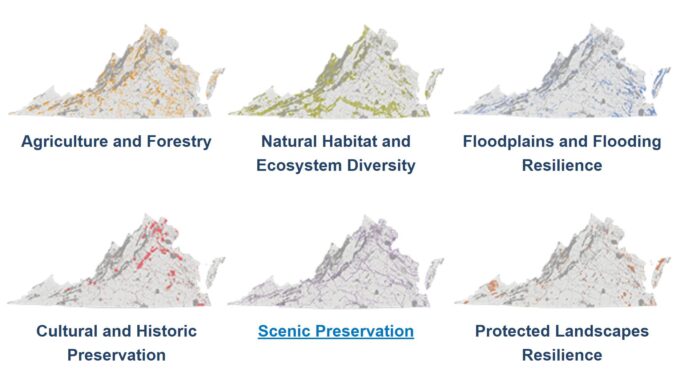Updates have been announced for ConserveVirginia, the Commonwealth’s data-driven land conservation strategy and multilayer mapping tool for identifying high value lands and conservation sites. ConserveVirginia 2.0 includes three significant changes that reinforce the state’s priorities on water quality and historic justice and equity.
The new features include a (1) water quality improvement layer to reduce nutrient and sediment loads to waterways; (2) an update to the mapped scenic rivers pursuant to legislation approved the past General Assembly session; and (3) an upgrade to the cultural and historic category to include battlefields that saw involvement from United States Colored Troops and other African-American units.
First launched in April 2019, ConserveVirginia uses technology to guide land conservation decisions to the highest priority lands. Twenty-one mapped inputs are divided into seven different categories that represent overarching conservation values. Since its launch, 117,085 acres identified as high priority conservation lands have been conserved.
“There is widespread consensus among conservationists that to prevent a mass extinction crisis, support a growing global population, and address climate change, we must conserve at least 30 percent of the planet by 2030,” said Secretary of Natural Resources Matthew J. Strickler. “If over time Virginia conserved all of the lands identified by ConserveVirginia, the Commonwealth would be a leader in meeting the 30 by 30 goal supported by scientists and advocates worldwide.”
New Water Quality Improvement Layer
ConserveVirginia has incorporated a seventh category to its model, a sweeping new water quality improvement layer which adds a total of 790,112 acres of high priority conservation lands for reducing pollution loads from nonpoint sources. It was developed through a partnership between the Department of Conservation and Recreation (DCR) and the Department of Environmental Quality (DEQ) using estimates of nitrogen, phosphorus, and sediment loadings from agricultural sources from three datasets including those of the Chesapeake Bay program and DEQ. This new category buffers waterways in watersheds identified in the 90th percentile for pollution loads from the three datasets.
“The buffers identified through ConserveVirginia are the lands where conservation would be most effective in order to maintain and improve water quality statewide, including the Chesapeake Bay,” said DCR Director Clyde Cristman. “With added benefits for fisheries, erosion control, and wildlife habitat, we are able to leverage land conservation to enhance water quality and human and ecosystem health.”
Additions to Scenic Preservation Category
The scenic preservation category identifies lands by mapping national and state-designated scenic byways, rivers, trails, etc. This past session, the General Assembly added scenic river designations to six waterways: The Pound, Maury, Staunton, James and Clinch Rivers, and Gray’s Creek across the river from Jamestowne in Surry County. These waterways have all been included in ConserveVirginia 2.0, an increase of 10,500 acres to buffer viewsheds along these waterways.
Updated Cultural and Historic Preservation Category
As part of the Governor’s initiatives on historic justice and equity, the cultural and historic preservation category has been updated with 128,964 acres that include Civil War battlefields where the brigades historically known as United States Colored Troops (USCT) were engaged. Approximately 175 regiments, comprising more than 178,000 free black soldiers and freedmen, served during the last two years of the Civil War, representing nearly one-tenth of all Union troops by the end of the war.
“Traditionally, battlefields have been evaluated by the strategic significance of the battle, rather than the contributions of those who fought at these historic sites,” said Department of Historic Resources Director Julie Langan. “By adding USCT battlefields to ConserveVirgina, we recognize the contributions of those often forgotten heroes, and tell a more inclusive and complete story, which furthers Governor Northam’s historic justice initiative.”
ConserveVirginia identifies a total of 6.9 million acres of high priority conservation areas across the Commonwealth. These data guide a long-term land conservation strategy for Virginia by serving as a “menu” to inform state land acquisitions, environmental mitigation projects, and Virginia Land Conservation Foundation and Land and Water Conservation Fund grants.
The categories are Agriculture and Forestry; Natural Habitat and Ecosystem Diversity; Floodplains and Flooding Resilience; Cultural and Historic Preservation; Scenic Preservation; Protected Landscapes Resilience; and Water Quality Improvement.
For more information about ConserveVirginia information and map layers, visit dcr.virginia.gov/conservevirginia.


